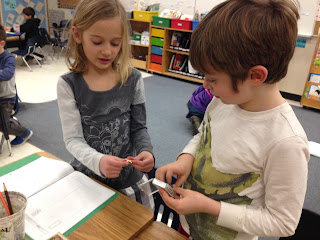I apologize that I am SO late posting the words of the week. To make it up to you, I'll give you an extra weekend on next week's sound and words (see below). Let's try very hard to all have our mot de la semaine books here on Mondays so that my tiny tree-saving pieces of paper can be taken care of and not lost in backpacks.
I am also very late in introducing Mr. G, a teacher candidate from York University, who will be working with our class every Wednesday for the next couple months and then take over much of the teaching in April or May. Please make Mr. G feel welcome around our school!
This week, we began our final project in our data management unit and are about half way through working on it. Through this project, each student will show their ability to gather information, sort it in a tally chart and present it in two types of diagrams that we have learned about. Already, each student has planned their survey question, including 3 choices, and visited another class to gather information. Each student practiced knocking and asking permission and then asking their survey question in front of our class first, and then went off in independent groups of 2 to do the same in front of another, sometimes much older, class. I've heard from some teachers that our students did a very good job and spoke very well in French. I think many students were excited to have their clipboard and visit other classes, but we were definitely nervous too. Everyone should feel very proud of having done this!
Now, we are all working on our first diagram, a bar graph. This time, students are doing all the hard work that I've done for them in previous diagrams, including drawing the axes with a ruler. So far everything is looking very good. Please ask your surveyor what their question is (they can tell you in French), what class they visited, how they felt about that experience, and what their results were!
In grade 1 science, we are beginning to investigate the properties of different materials. These investigations will help us make decisions about what materials might be appropriate when we go to build something. This week, we have investigated different types of chairs and we did some centres to identify materials that are lisse and rugueux. Ask your scientist what those words mean! At each centre, there was one example of each. One partner (the student), closed their eyes and the other partner (the teacher), placed the objects in their hands so that they could feel for the difference. Ask your scientist what types of objects they felt and if any of them were surprising (e.g., we would think a rock would be rough, but...).
Words of the Week
We are now going to start increasing the number of grade 1 words per
week until we reach 10.
This week we have the sound ‘ui’. We’re all familiar with this sound because of one of the first
words we ever learned, “oui” (=yes). It sounds just like the word “we”
in English.
It is common to see students write “je swi” for “je suis”.
This is exactly how it sounds, and they’re using what they know about the
letter w, so it’s all good. Because
“je suis” is so frequently used, we’ll start correcting it in our writing now
so that we get in the good habit of spelling it correctly.
Grade 1: oui, huit, puis, fruit, je suis
Bonus words: juillet, cuillère
Grade 2: oui, parapluie, nuit, puis, je suis
Words of next Week
The letter C can
make three different sounds in French. On its own it can be either soft (‘s’)
or hard (‘k’). The vowel that follows can help you decide which it is, but
there are always exceptions. In general, a c
followed by an e, i, or y is soft. A c followed
by a, o, or u is hard. When a c has that funny little thing that
looks like a 5 under it (called a cédille)
it is always soft. You’ll see in our words with c-cédille that those c’s would normally be hard, but the cédille breaks the
rule. This is a lot to remember, so I
haven’t shared all this with the kids, they just know that ç makes ‘s’.
The third sound that c
can make, when followed by h, is ‘ch’ - sounds like the English ‘sh’.
Grade 1: ça, garçon, glaçon, le chat, le chien,
le cochon
Bonus words: la vache, le cheval
Grade 2: balançoire, garçon, glaçon,
le cochon, la chèvre
Tamara
P.S. - You know that in my other life I'm a musician... In the past, I've let my students and families know when I had a solo coming up at church, and it's been a joy to see them there. This gig is a bit later in the evening, but it's going to be super fun. All doo-wop music from the 50s & 60s. Please share with anyone who might be interested!














